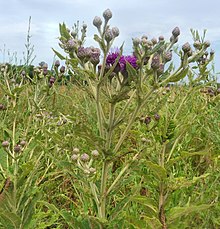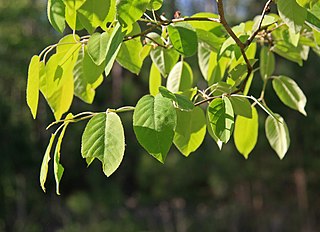
Amelanchier arborea, is native to eastern North America from the Gulf Coast north to Thunder Bay in Ontario and Lake St. John in Quebec, and west to Texas and Minnesota.
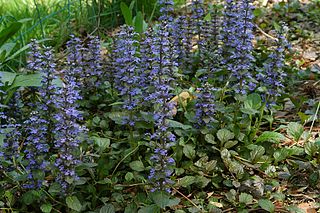
Ajuga reptans is commonly known as bugle, blue bugle, bugleherb, bugleweed, carpetweed, carpet bugleweed, and common bugle, and traditionally but less commonly as St. Lawrence plant. It is an herbaceous flowering plant, in the mint family, native to Europe. It is invasive in parts of North America. Ajuga reptans is also a component of purple moor grass and rush pastures, a Biodiversity Action Plan habitat in the United Kingdom.

Cornus alternifolia is a species of flowering plant in the dogwood family Cornaceae, native to eastern North America, from Newfoundland west to southern Manitoba and Minnesota, and south to northern Florida and Mississippi. It is rare in the southern United States. It is commonly known as green osier, alternate-leaved dogwood, and pagoda dogwood.

Sporobolus heterolepis, commonly known as prairie dropseed, is a species of prairie grass native to the tallgrass and mixed grass prairies of central North America from Texas to southern Canada. It is also found further east, to the Atlantic coast of the United States and Canada, but is much less common beyond the Great Plains and is restricted to specialized habitats. It is found in 27 states and four Canadian provinces.

Filipendula rubra, also known as queen-of-the-prairie, is a species of flowering plant in the family Rosaceae native to the northeastern and central United States and southeastern Canada. It prefers full sun or partial shade and moist soil, but tolerates drier soil in a shadier location. It grows tall and firm, and produces blooms that are tiny and pink above its ferny, pointy leaves.

Galearis spectabilis, commonly known as showy orchis or showy orchid, is an orchid species of the genus Galearis. It is native to eastern Canada and much of the eastern half of the United States.
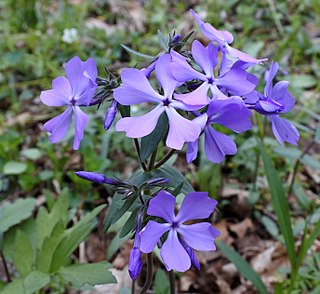
Phlox divaricata, the wild blue phlox, woodland phlox, or wild sweet william, is a species of flowering plant in the family Polemoniaceae, native to forests and fields in eastern North America.
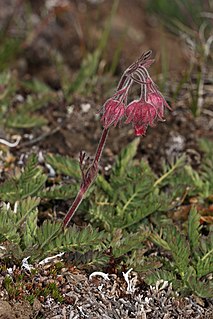
Geum triflorum, prairie smoke, three-flowered avens, or old man's whiskers, is a spring-blooming perennial herbaceous plant of North America from northern Canada to California and east to New York. The flowers bloom from mid-spring to early summer.

Phlox pilosa, the downy phlox or prairie phlox, is an herbaceous plant in the family Polemoniaceae. It is native to eastern North America, where it is found in open areas such as prairies and woodlands.
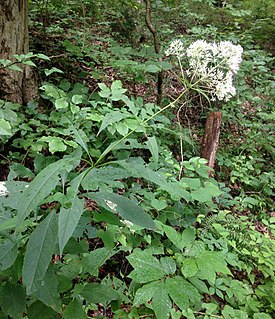
Eutrochium purpureum, commonly known as purple Joe-Pye weed or sweetscented joe pye weed, is an herbaceous perennial plant in the family Asteraceae. It is native to eastern and central North America, from Ontario east to New Hampshire and south as far as Florida, Louisiana, and Oklahoma.
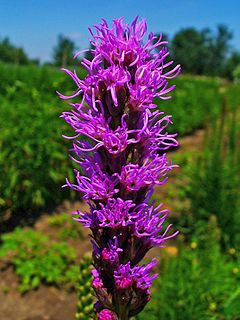
Liatris spicata, the dense blazing star or prairie feather, is an herbaceous perennial flowering plant in the family Asteraceae. It is native to eastern North America where it grows in moist prairies and sedge meadows.

Lonicera sempervirens is a species of honeysuckle vine native to the eastern United States which is known for its reddish flowers.

Euphorbia corollata is an herbaceous perennial plant in the family Euphorbiaceae that is native to North America. A common name for the species is flowering spurge. It has a milky sap that can cause skin and eye irritation in some people. It grows up to 1 m (3 ft) tall, with smooth stems and light green leaves arranged alternately or in whorls. Leaves are about 10 mm wide and 75 mm (3 in) long. Each stem terminates in a panicle 20 to 25 mm across. Flowers are about 6 mm across and consist of one pistillate and several staminate flowers surrounded by five white bracts - not petals but formed from the involucre at the base of the flowers. Flowering spurge blooms from June to September.
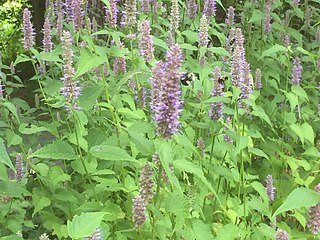
Agastache foeniculum, commonly called anise hyssop, blue giant hyssop, Fragrant giant hyssop, or the lavender giant hyssop, is a species of perennial plant in the mint family, (Lamiaceae). This plant is native to much of north-central and northern North America, notably the Great Plains and other prairies. It is tolerant of deer and drought, and also attracts hummingbirds, butterflies, bumblebees, honey bees, carpenter bees, and night flying moths.

Vernonia gigantea is a species of perennial plant from family Asteraceae found in United States and Canada. The plant is native to the eastern United States, north to New York state and Ontario, and southwest to Texas.

Vernonia arkansana is a species of perennial plant from family Asteraceae found in south-central United States. The plant is 4–6 feet (1.2–1.8 m) high and 3–4 feet (0.91–1.22 m) wide. The flowers bloom from August to September and are pink-purple coloured. It is a recipient of the Royal Horticultural Society's Award of Garden Merit.
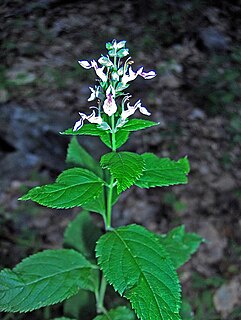
Teucrium canadense, commonly known as Canada germander, American germander or wood sage, is a perennial herb in the family Lamiaceae. It is native to North America where it is found across the contiguous states of the United States and in much of Canada.
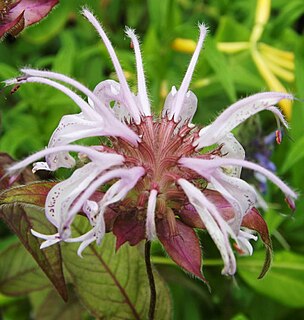
Monarda bradburiana, the eastern beebalm or Bradbury's beebalm, is a species of perennial flowering plant in the mint family, Lamiaceae, that is native to much of the southeastern United States.

Vernonia baldwinii, the western ironweed or Baldwin's ironweed, is a perennial herb native to central North America.

Vernonia fasciculata, the smooth ironweed or common ironweed, or prairie ironweed is a species of perennial plant from family Asteraceae. It is native to Manitoba in Canada and the north-central U.S.A.
